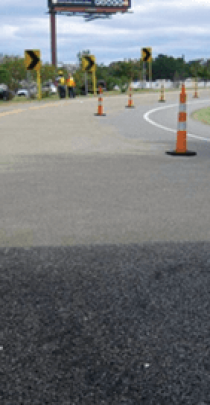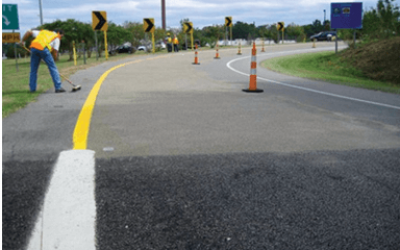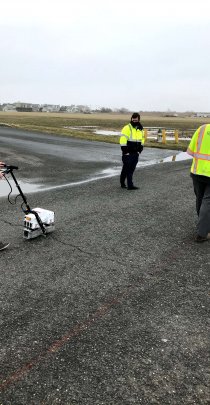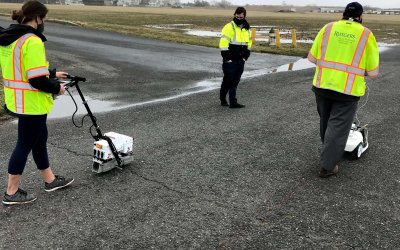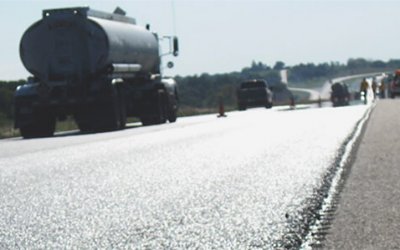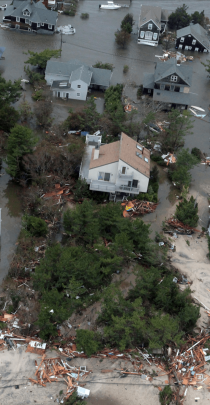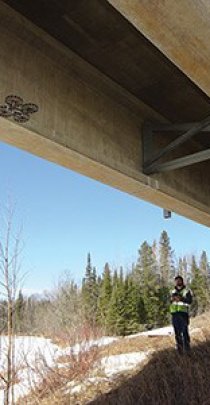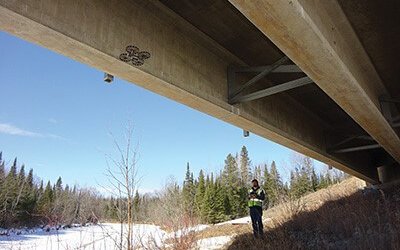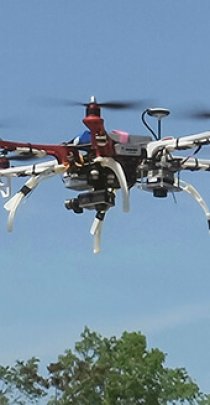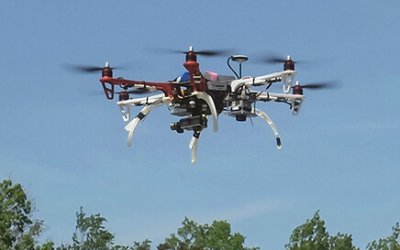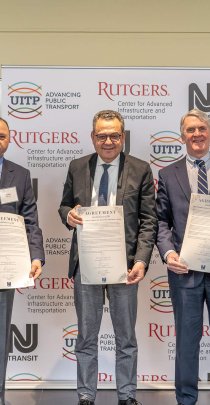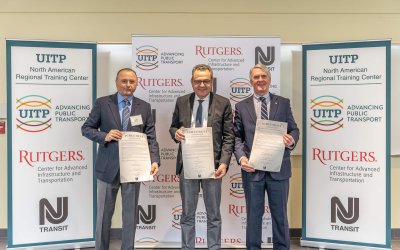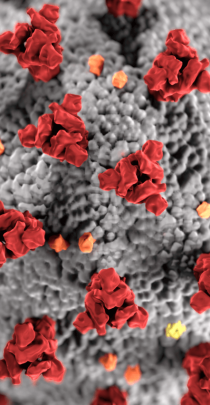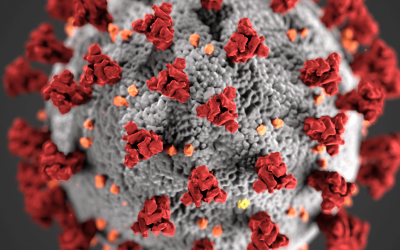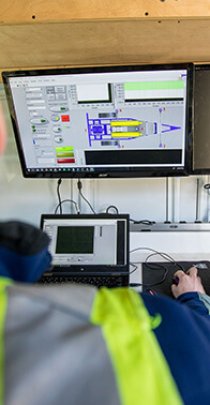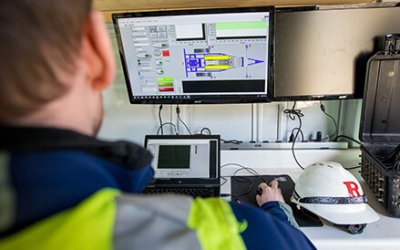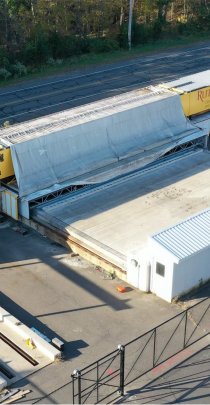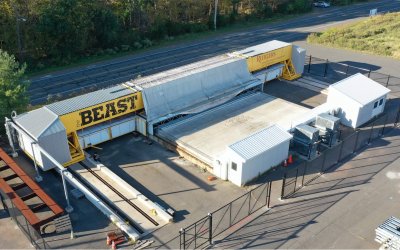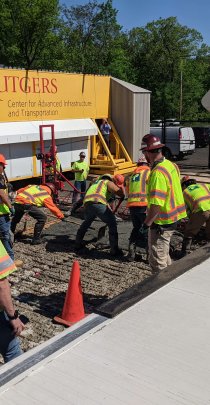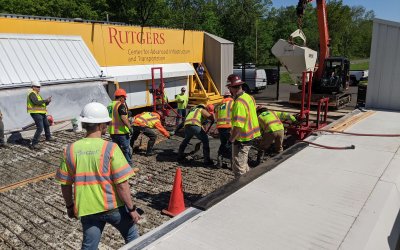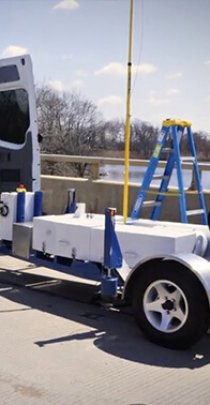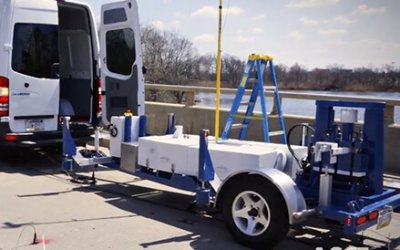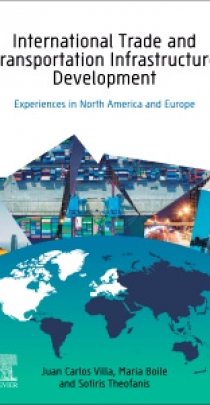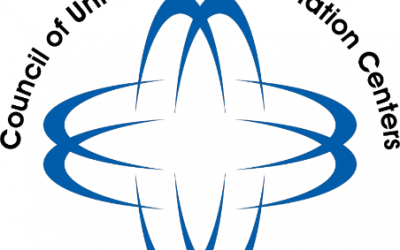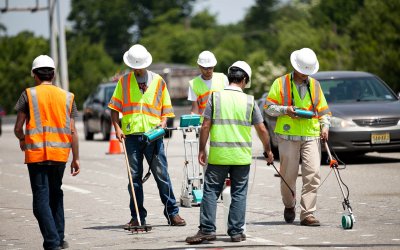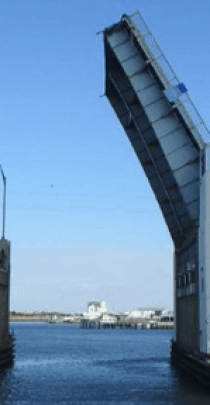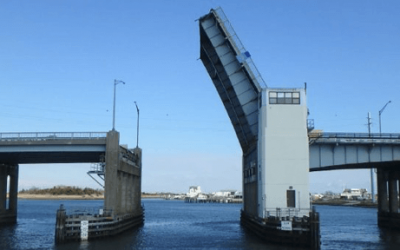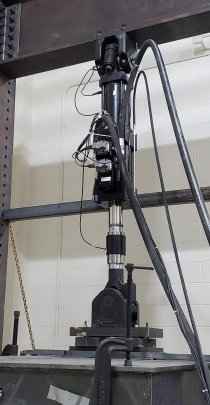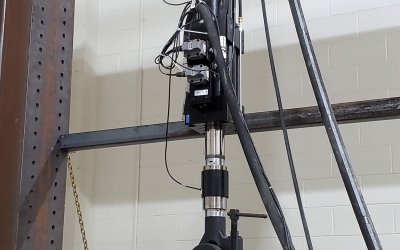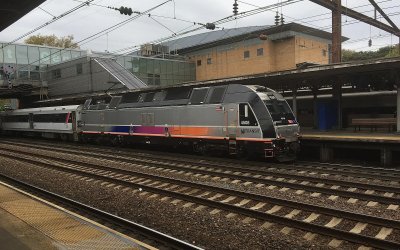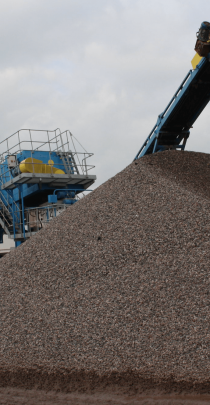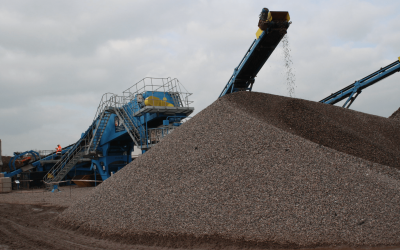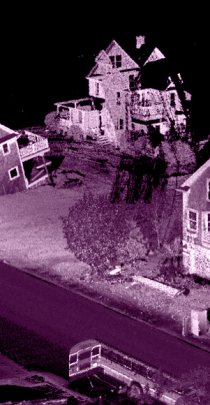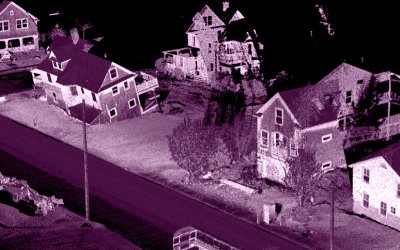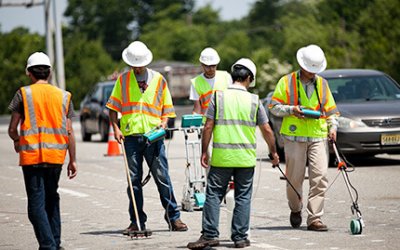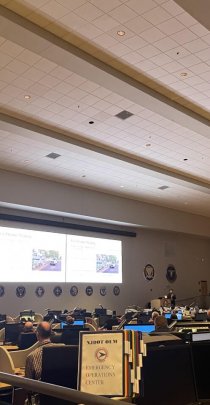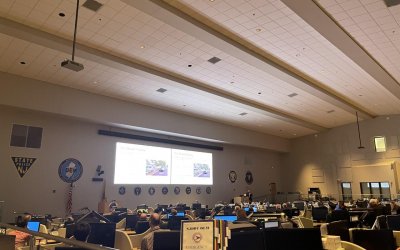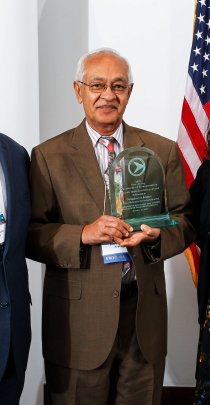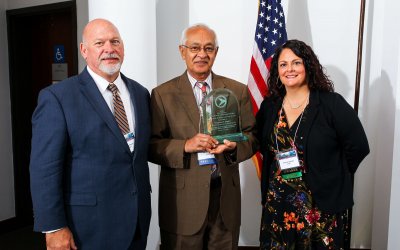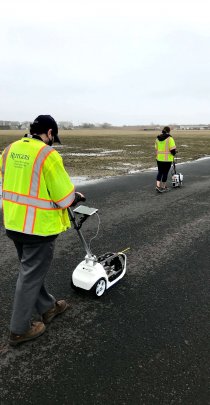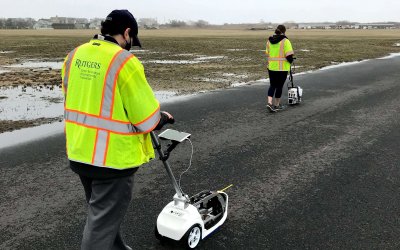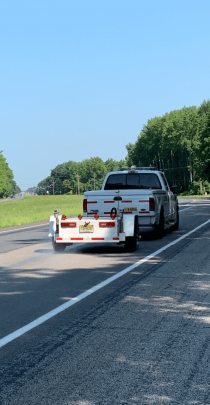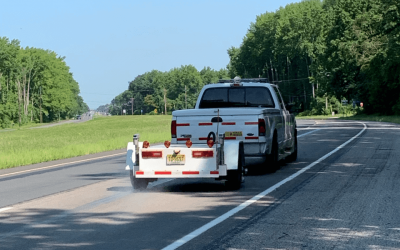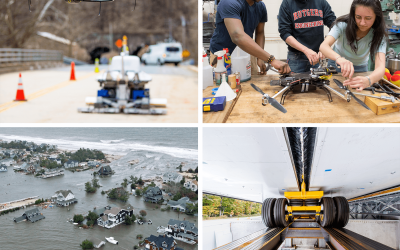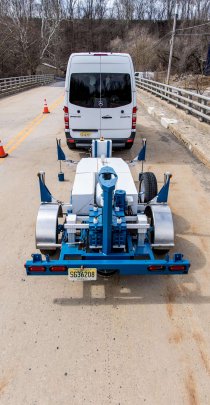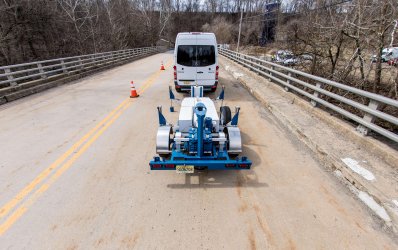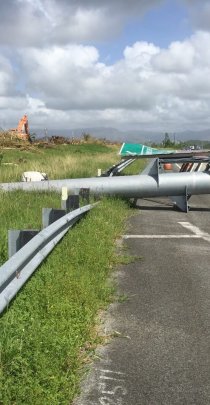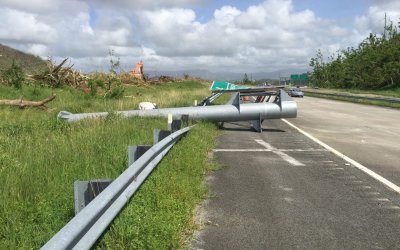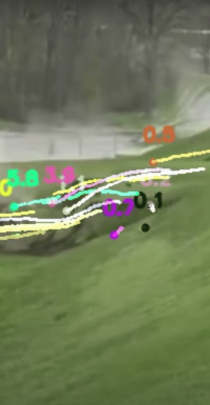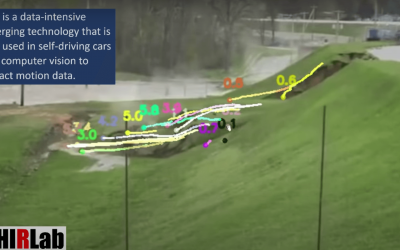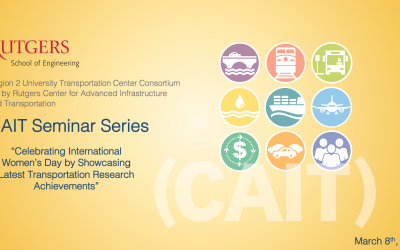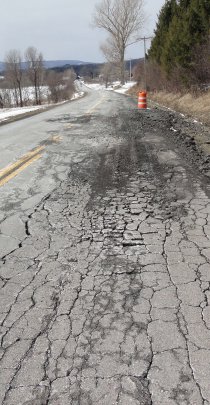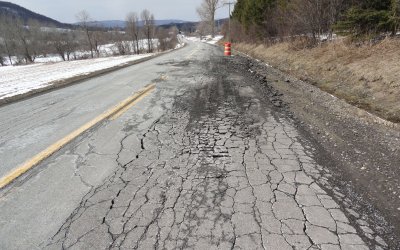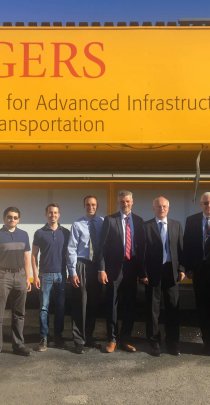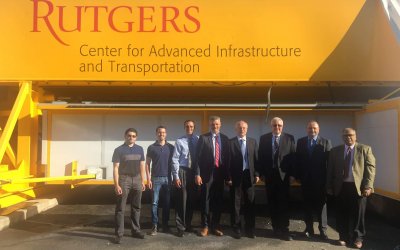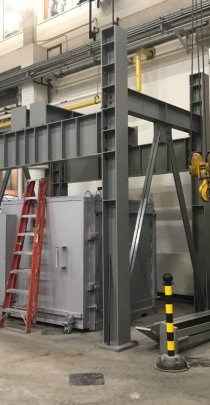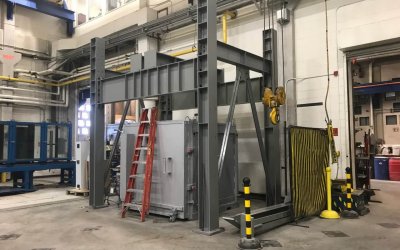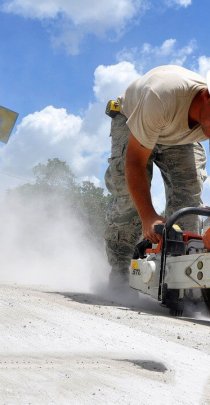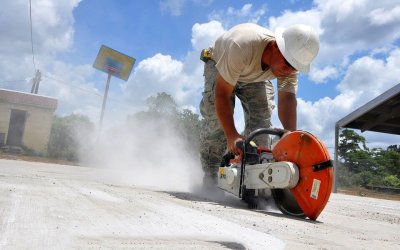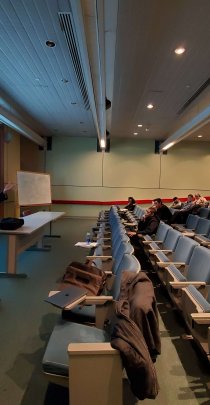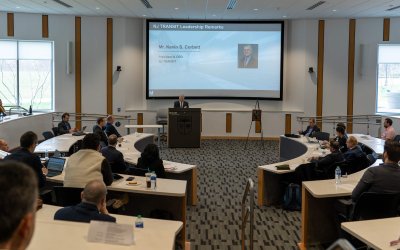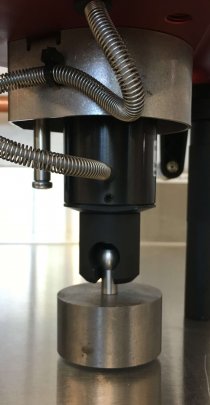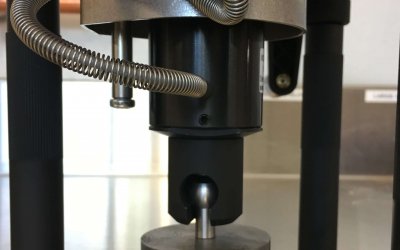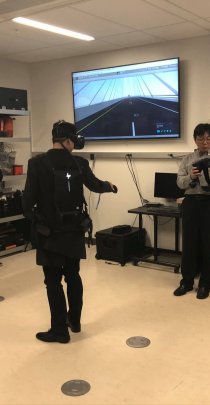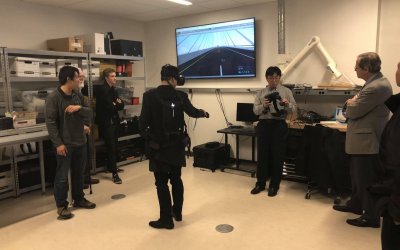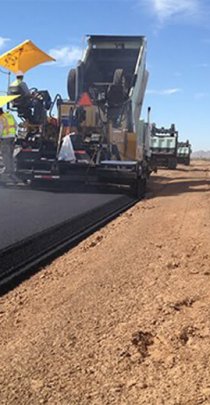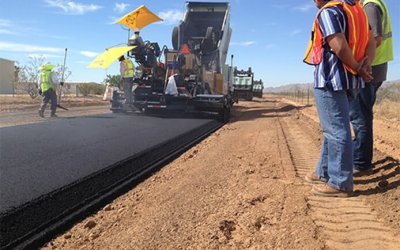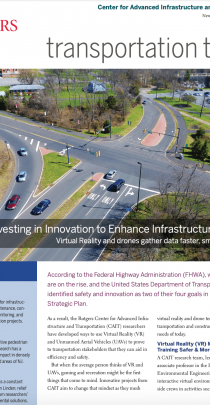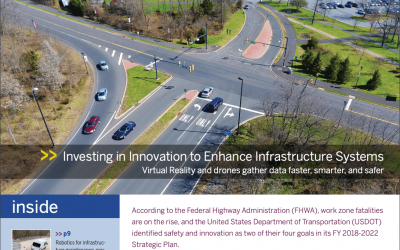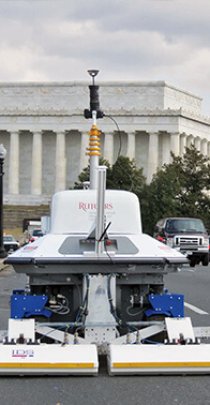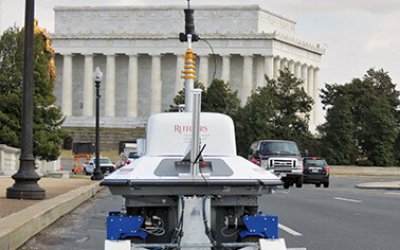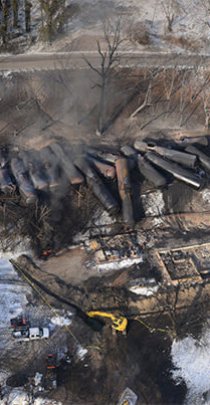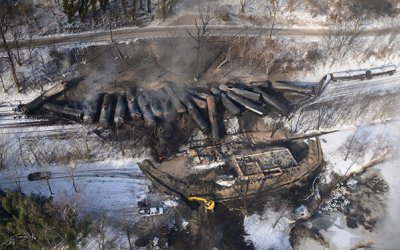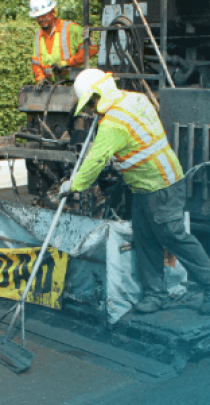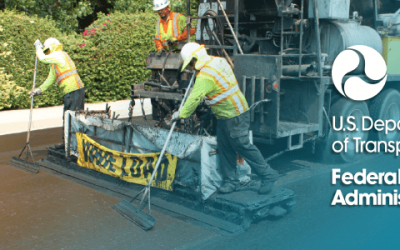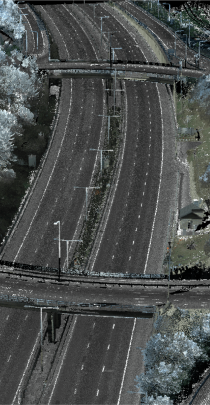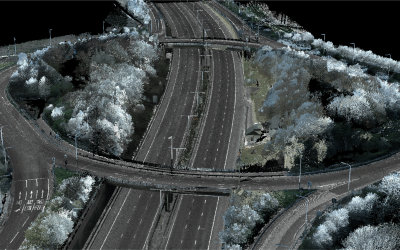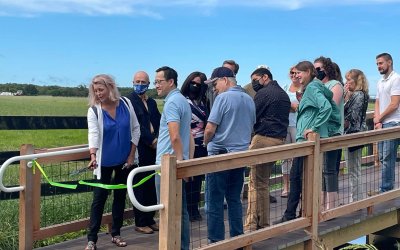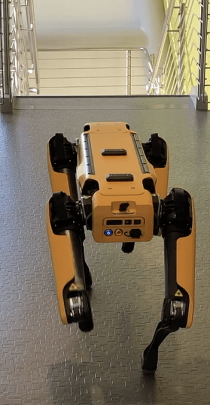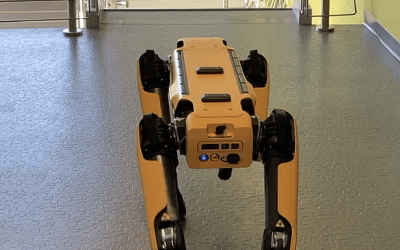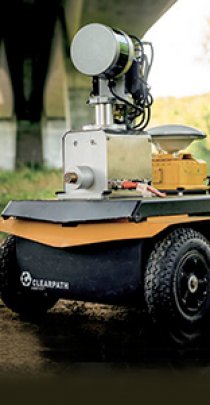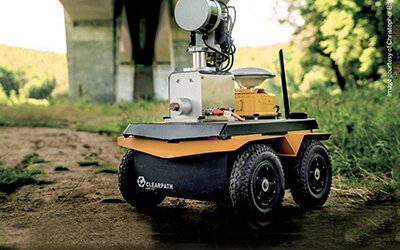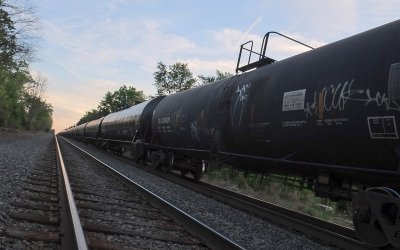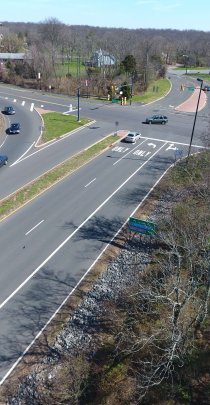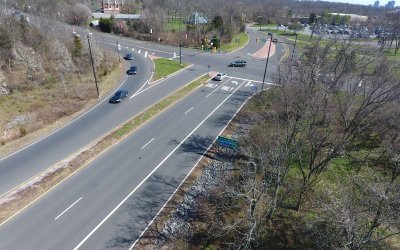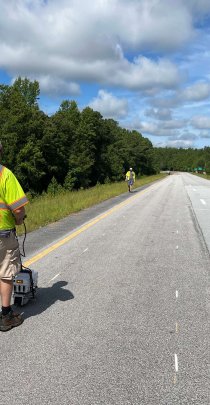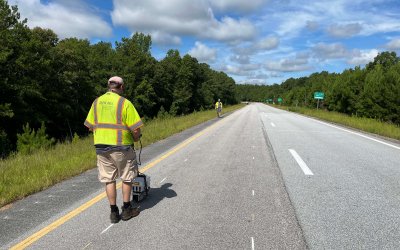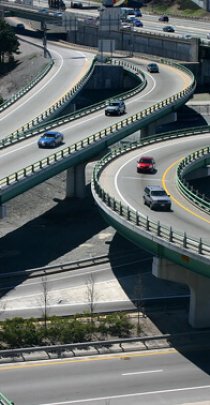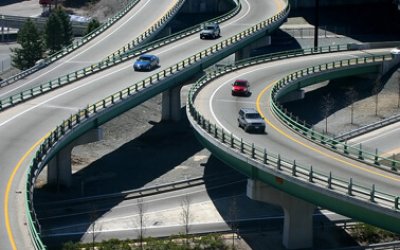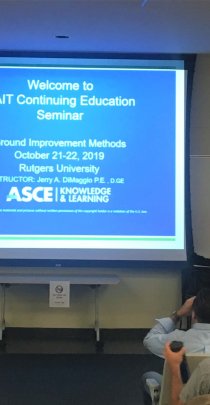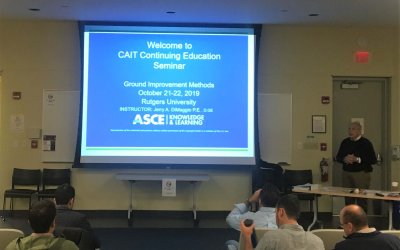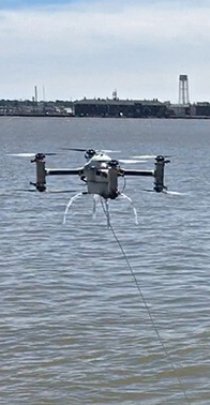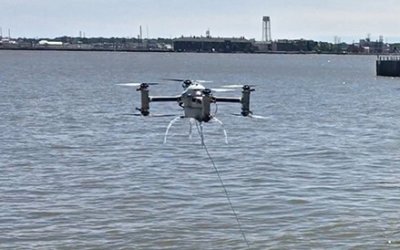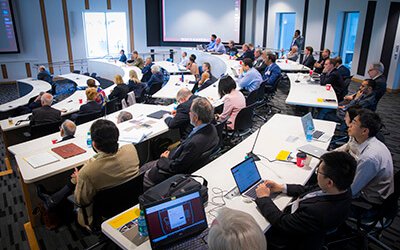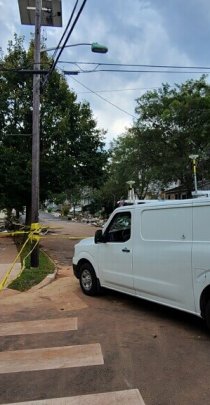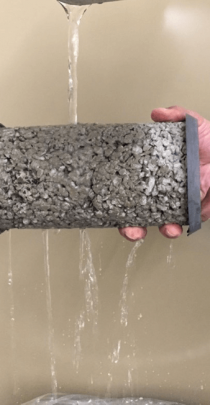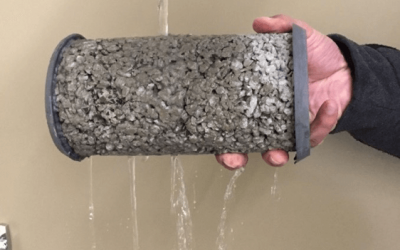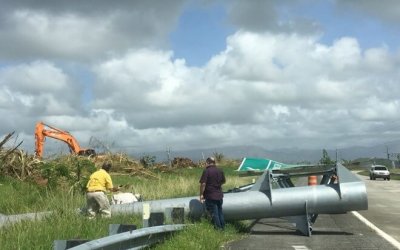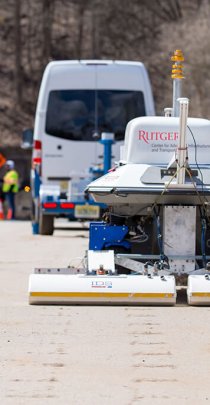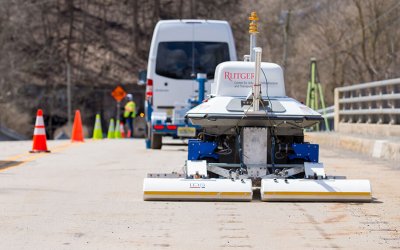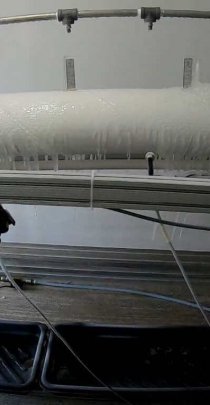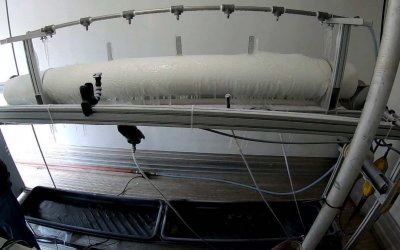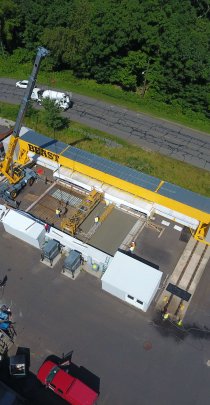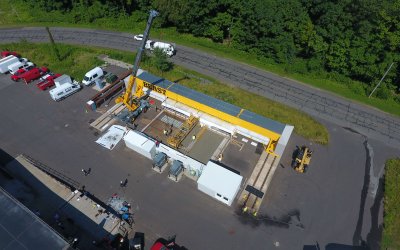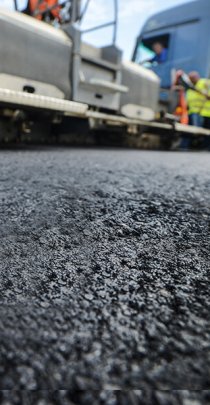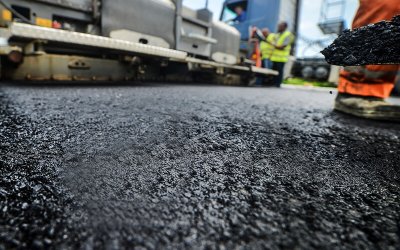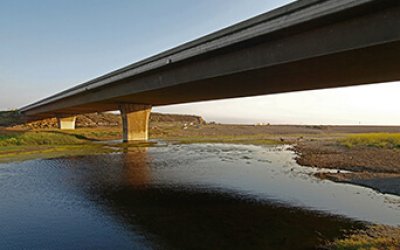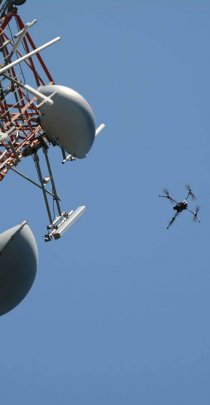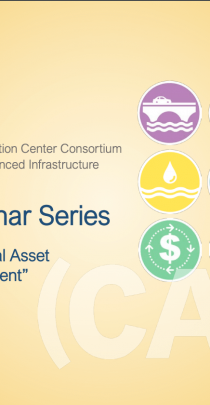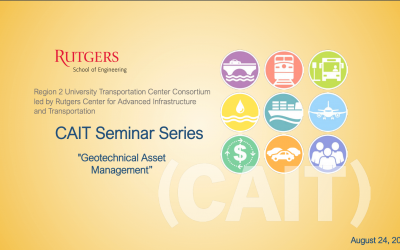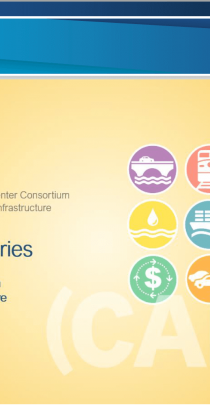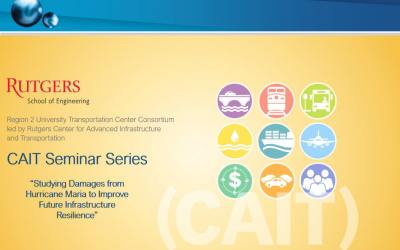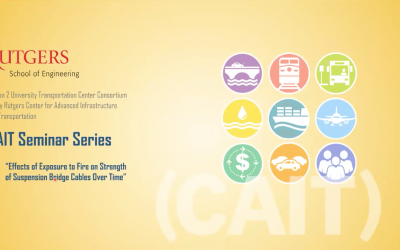Quantitative information on infrastructure health—inside and out. CAIT tools can now provide comprehensive visualization of an asset’s condition faster and more accurately than ever before.
Training & Events
NJLTAP - Asphalt Roads: Common Maintenance Problems (In-person)
The course material reviews the importance of preventive maintenance to the life of an asphalt pavement. The material will help the student identify common asphalt distresses and the appropriate treatments.
NJLTAP - Pavement Management Systems (In-Person)
Pavement Management Systems provides the basics for developing a pavement management system to help local governments manage their pavement network by providing an understanding of the concept and importance of road surface inventories and condition surveys.
NJLTAP - Principles of Paving (In-Person)
This course is for municipal or county employees and those that work with them who are involved in the planning, inspecting and placing of asphalt pavements. The course will provide the information needed to properly plan and monitor a hot mix asphalt paving project.
News
2022 Northeast Coastal Conference Highlights Resilience Work Since Superstorm Sandy
On the 10th Anniversary of Superstorm Sandy, the 2022 Northeast Coastal Conference brought together experts and industry leaders to discuss what we have learned, ongoing research and projects that are making our shores and coastal communities safer, and new ways we can continue to build a more resilient future.
A new view for bridge inspectors
Connected directly to a drone’s video feed, first-person view (FPV) goggles allow bridge inspectors to get up close and personal with the components they are examining. FPVs provide a perspective that is equivalent to what they would see from about three feet away.
For students who dream of flying
A grant from the NSF helped launch Atlantic Cape Community College’s new associate’s degree program in applied science with a concentration on small commercial drone field technicians.
CAIT Partners with NJ TRANSIT and International Association on Rail Training Center
A new center designed to educate the current and next generation of transportation leaders to be resilient to challenges of the 21st century has been established at Rutgers through a partnership with two industry leaders.
An Updated Look at The Effects of COVID-19 on Transportation and Infrastructure
Last month we spoke to CAIT-affiliated researcher Dr. James Hughes to discuss COVID-19 and its potential impacts on the economy and regional transportation. Now we check back with him again for new insights as the situation progresses.
THMPER featured in Civil Engineering magazine
The February 2018 issue of CE magazine featured THMPER—a portable, rapid testing device for bridge load-bearing capacity. THMPER is a breakthrough because it does this critical task faster, cheaper, and with less traffic disruption than other current methods.
ASCE Features NYC Digital Twin Research By UTC Partners at Columbia
A three-year project at Columbia University is building Digital Twins of intersections, roadways, and other key infrastructure in New York City to monitor and map traffic flow throughout the city. Using Digital Twins can help officials simulate traffic and congestion conditions and test potential mitigation strategies.
UHPC Bridge Preservation & Repair Research at The BEAST
CAIT's BEAST Lab has been testing a full-scale, 50-ft. bridge deck for a project sponsored by the FHWA to learn about how the bridge deteriorates under exposure to extreme environmental conditions and traffic loading — and to evaluate emerging bridge preservation technologies such as UHPC.
BEAST Lab Studies Innovative UHPC Material for Bridge Preservation & Repair
This summer, the BEAST Lab at Rutgers CAIT began to evaluate emerging bridge preservation technologies in addition to ongoing testing of a full-scale, 50-ft. bridge deck. Specifically, researchers started investigating UHPC to establish measurements of the material’s long-term performance under real-world conditions.
Bridge evaluation device lands prestigious Pankow Innovation Award
THMPER determines bridge load ratings faster, cheaper, and with less traffic disruption than other current methods. A portable evaluation tool and data lab, it employs three refined methods outlined by AASHTO: modal impact testing, refined analysis, and calibration of FE element models.
Building connections that last
FHWA is promoting ultra-high performance concrete to improve the strength, simplicity, and durability of prefabricated bridge element connections. This innovation builds on field experience of dozens of states in the U.S. since 2009.
CAIT Affiliated Researchers Publish New Book on Impacts of Trade on Transportation
CAIT-affiliated researchers examine the impact of major trade agreements such as NAFTA and the European Union Customs Union, and their implications on transportation systems globally.
Associate Director Elected Secretary of Council of University Transportation Centers
The Associate Director of CAIT, Dr. Patrick Szary, has served on the executive committee of CUTC previously as well as playing an instrumental role in both leading CAIT’s research in aligning with the national vision of USDOT while also engaging regional stakeholders and developing the Center as a dynamic resource.
CAIT Associate Director Elected CUTC VP for 2021-2022
Dr. Szary leads CAIT’s research efforts helping to align them with USDOT’s national vision and the needs of stakeholders in the Northeast region. He has been a member of CUTC’s executive board previously, most recently serving as Secretary last year.
CAIT Awarded $3.5 million from USDOT UTC program
Rutgers’ CAIT was awarded a $3.5 million grant from USDOT’s Research and Innovative Technology Administration under the University Transportation Center (UTC) program. This is the third time CAIT has successfully competed to retain its UTC status.
CAIT Awarded Bridge Resource Program to Support NJDOT Research
The BRP is aimed at preserving bridges in the state, enhancing the condition of key transportation infrastructure, and developing new technologies to help engineers build with resilience in mind.
CAIT Develops Flood Risk & Resilience Analysis Tool with US Virgin Islands
Working with the University of the Virgin Islands, CAIT researchers have developed a Flood Risk and Resilience Analysis Tool that can assess and visualize risk for roadways and other infrastructure susceptible to flooding and storms. It was built based on real flood data and the US Virgin Islands transportation system.
CAIT Director Named to NJ’s Restart and Recovery Advisory Council
New Jersey Governor Phil Murphy recently announced the formation of a statewide council of leaders from various industry, community, and faith-based groups and institutions across New Jersey to work together and advise on the state’s restart and recovery from the COVID-19 pandemic.
CAIT Expands Large-Scale Testing Equipment for Bridge-Deck Development Research
Rutgers CAIT recently enhanced capability in large-scale structural-testing equipment that will enable full utilization of its existing laboratory infrastructure and expand its portfolio in transportation research by providing access to a capability that currently does not exist in any other university in NJ and the region.
CAIT experts testify before NJ Assembly transportation committee
CAIT director Dr. Ali Maher and civil engineering professor Dr. Franklin Moon offered their thoughts on New Jersey infrastructure and encouraged lawmakers to view researchers in higher education as a resource and partner for finding solutions to the state’s pressing issues.
CAIT Helps Secure Funding for Advancement of Portal North Bridge Replacement Project
The 110-year-old Portal North Bridge carries approximately 450 trains and 200,000 passengers on an average day, and is in need of repair. CAIT helped to secure new funding from FRA that will allow NJ Transit and other stakeholders to advance these vital infrastructure projects.
CAIT Launches Infrastructure Asset Management Academy
The Infrastructure Asset Management Academy for Engineers and Planners is a 6-course program taught by experts at CAIT and industry partners designed to provide students with the knowledge, tools, and experience needed to make more informed asset management decisions.
CAIT Partners with ARA on Geotechnical Research Contract
ARA was selected as a contractor to provide program support and engineering services to the FHWA’s Office of Bridges and Structures and National Geotechnical Team. CAIT has teamed up with them as a subcontractor to provide research support and expertise.
Best Practices for Deploying Real-Time Traffic Signal Performance Monitoring
Traffic congestion costs the US billions each year in productivity as commuters find themselves stuck on the nation’s crowded roadways. As more people use the transportation system, investment in innovative, intelligent technology is needed to ensure that current infrastructure can support the growing need.
CAIT Research Helps NJ Transit Secure Funding for State of Good Repair Projects
The FRA issued a notice of funding opportunity for state of good repair projects including a total of $291.4 million in grant funding to help repair vital intercity passenger rail assets. Of that funding, NJ Transit was later awarded $18.3 million to upgrade the Trenton Transit Center, and CAIT helped to secure it.
CAIT Research Helps NYC Engineers Monitor Structural Health of Manhattan Bridge
Researchers are developing a new tool to monitor track misalignment on the Manhattan Bridge that will help NYC engineers make informed repair and rehabilitation decisions in the future. They are also investigating the impact of dynamic amplification on bridge-fatigue life and possible mitigation options.
CAIT Research Provides Guidelines on Recycled Concrete Aggregate Implementation
Due to how it is sourced and produced, the mechanical properties and characteristics of Recycled Concrete Aggregate can vary greatly. As demand for this material grows, it is important for the construction industry to understand the nature of RCA and how it can be applied to different projects.
CAIT Researcher Awarded 2-Year FEMA Hazard Mitigation Grant
Dr. Jie Gong’s recent work has focused on promoting coastal resilience, including leading remote sensing-based post-disaster reconnaissance missions during Hurricane Sandy and other storms with the goal of advancing damage assessment methods and turning data into actionable knowledge.
UTC Research Compares Pavement Condition Indexes To Help Estimate Service Life
New research from Rutgers CAIT is examining the consistency and relationship of three Pavement Condition Indexes. Analyzing them can result in more durable and sustainable airfield pavement in the long-term, and has the potential to help find improvements to the current practices in airfield-pavement management systems.
Researcher Models Economic Impact of Raritan River Bridge Replacement Project
The NJ Transit Board of Directors recently approved an approximately $250 million contract with George Harms Construction for the initial construction phase of the Raritan River Bridge Replacement project. A study by CAIT-affiliated researchers helped to gauge the economic impact of the Raritan River Bridge project.
CAIT Researcher Participates in GatewayJFK "On the Move" Industry Event
GatewayJFK "On the Move" celebrated industry, community partners, government, residents and next generation Movers & Shakers in the off-airport cargo and supply chain community.
CAIT Researcher Speaks at Capitol Hill on Gaps in Infrastructure Resilience
The Coastal Universities Coalition is a consortium of the nation’s leading academic institutions convened to develop science-based solutions to the most pressing issues facing populated coastal regions. This month, a CAIT researcher was invited by the organization to speak on infrastructure resilience.
CAIT Researcher Speaks on the State-of-the-Art in NDE and Bridge Assessment Tech
On September 16th from 2-3 pm, Rutgers Center for Advanced Infrastructure and Transportation (CAIT) hosted affiliated researcher Dr. Nenad Gucunski for a presentation on the state-of-the-art in the use of Nondestructive Evaluation and other technologies for the comprehensive assessment of concrete bridges.
CAIT Researcher Trains NJ Agencies on Statewide Resilience Planning Using New Tech
Dr. Jie Gong gave a 3-hour course earlier this fall on statewide infrastructure resilience to storms, flooding, and other natural disasters at the NJ Regional Intelligence Operation Center.
CAIT Researcher Validates Paratransit Skills Assessment and Wins TRB Best Paper Award
A recent paper from Rutgers CAIT validated the Paratransit Skills Assessment and found it can predict an individual's ability to use paratransit services with greater than 96% accuracy.
CAIT Researcher Wins ASCE Huber Prize Recognizing His Research Achievements
The Walter L. Huber Civil Engineering Research Prizes are awarded to ASCE members for notable achievements in research related to civil engineering. Dr. Hao Wang was recognized by ASCE with a Huber Prize this year for his innovative research developing durable and smart pavement systems.
CAIT Researcher Recognized at 21st Annual NJDOT Research Showcase
This year, a Rutgers and CAIT-affiliated faculty member took home the 2019 NJDOT Research Implementation Award for his innovative work on the development of a new protocol for accepting new coating systems.
Researchers Contribute to Center of Excellence Developing Threat Assessment Solutions
Rutgers CAIT researchers Dr. Peter Jin and Dr. Jie Gong are contributing research on digital twin projects as part of a new Center of Excellence for Engineering Secure Environments from Targeted Attacks at Rutgers University that will combat potential threats to buildings, schools, stadiums, and other infrastructure.
CAIT Researchers Evaluate New Equipment to Help NJ Monitor Pavement Condition
Inaccurate network pavement data can impact pavement management decisions such as roadway repairs and more. CAIT researchers at the Rutgers Asphalt Pavement Lab are working with NJDOT to test new pavement inspection equipment and locations to ensure data is accurate and representative of roads in New Jersey.
CAIT Researchers Featured for Innovative ‘Engineering Advances’ Across New Jersey
CAIT researchers have been driving advanced engineering solutions into practice here in NJ. A few experts at CAIT were highlighted by NJBIZ last month in an article on "Engineering Advances."
TRB Journal Features CAIT Study for Development of Clustered Traffic Inputs
Traffic load and vehicle weight are two important variables in doing proper pavement design. A new study analyzed traffic clusters in New Jersey to characterize the data into mechanistic-empirical pavement design. This will help the state better understand its roads and build better designs in the future.
CAIT Researchers Test HFST Across NJ for Performance and Service Life
A report from CAIT researcher Dr. Thomas Bennert, in collaboration with stakeholders from NJDOT, tests the performance of existing High Friction Surface Treatment installations at locations in New Jersey, as well as the viability of alternatives such as High Friction Chip Seal for areas showing signs of premature failure.
CAIT Researchers Turn Damage from Hurricane Maria into Actionable Resilience Data
In the years following the devastation that Hurricane Maria caused for Puerto Rico, CAIT-affiliated researchers at PUPR have been collecting field data from damaged traffic signs and bridges, testing these transportation assets to better understand their structural failures and breaking points during the storm.
CAIT chosen to lead USDOT Region 2 University Transportation Center
The Region 2 UTC consortium is focusing on developing practical tools and methods to improve infrastructure health, durability, and resilience. Partners are: Atlantic Cape Community College, Columbia, Cornell, NJIT, Polytechnic University of Puerto Rico, Princeton, Rowan, SUNY–Farmingdale, and University at Buffalo.
Effects of Exposure to Fire on Strength of Suspension Bridge Cables Over Time
On December 9th from 2-3 pm, CAIT-affiliated researchers will give a webinar on "Effects of Exposure to Fire on Strength of Suspension Bridge Cables Over Time" as part of the ongoing CAIT Seminar Series.
CAIT Seminar Series: Enhancing the Resilience of Tunnels Subject to Fire Events
On Thursday, February 25th, Rutgers CAIT will host UTC partners at the University at Buffalo for a seminar discussing their latest research quantifying damage to concrete tunnel lining during fire events in order to recommend proper mitigation actions and improve overall resilience of tunnels.
CAIT Seminar Series: State-of-the-Art in the Use of Nondestructive Evaluation
On Wednesday, September 16th, from 2-3 pm, Rutgers Center for Advanced Infrastructure and Transportation (CAIT) will host the next installment of its ongoing seminar series on the state of the art in nondestructive evaluation (NDE) and other technologies for the assessment of concrete bridges.
Studying Damages from Hurricane Maria to Improve Infrastructure Resilience
On January 29th, 2021, from 2-3 pm EST CAIT will host UTC partners from the Polytechnic University of Puerto Rico for a seminar on their latest research studying damages from Hurricane Maria to improve future infrastructure resilience.
CAIT Update, April 2021
News from the USDOT Region 2 University Transportation Center led by Rutgers CAIT.
CAIT Update, April 2022
News from the USDOT Region 2 University Transportation Center led by Rutgers CAIT.
CAIT Update Enews, August 2019
News from the USDOT Region 2 University Transportation Center led by Rutgers Center for Advanced Infrastructure and Transportation. Includes stories on recent events, research, and faculty accomplishments and activities.
CAIT Update, August 2020
News from the USDOT Region 2 University Transportation Center led by Rutgers CAIT.
CAIT Update, December 2019
News from the USDOT Region 2 University Transportation Center led by Rutgers CAIT.
CAIT Update, December 2020
News from the USDOT Region 2 University Transportation Center led by Rutgers CAIT.
CAIT Update, December 2021
News from the USDOT Region 2 University Transportation Center led by Rutgers CAIT.
CAIT Update, December 2022
News from the USDOT Region 2 University Transportation Center led by Rutgers CAIT.
CAIT Update, February 2020
News from the USDOT Region 2 University Transportation Center led by Rutgers CAIT.
CAIT Update, February 2021
News from the USDOT Region 2 University Transportation Center led by Rutgers CAIT.
CAIT Update, February 2023
News from the USDOT Region 2 University Transportation Center led by Rutgers CAIT.
CAIT Update, January 2020
News from the USDOT Region 2 University Transportation Center led by Rutgers CAIT.
CAIT Update Enews, July 2019
News from the USDOT Region 2 University Transportation Center led by Rutgers Center for Advanced Infrastructure and Transportation. Includes stories on recent events, research, and faculty accomplishments and activities.
CAIT Update, July 2020
News from the USDOT Region 2 University Transportation Center led by Rutgers CAIT.
CAIT Update, July 2021
News from the USDOT Region 2 University Transportation Center led by Rutgers CAIT.
CAIT Update, Jun 2020
News from the USDOT Region 2 University Transportation Center led by Rutgers CAIT.
CAIT Update, June 2021
News from the USDOT Region 2 University Transportation Center led by Rutgers CAIT.
CAIT Update, March 2020
News from the USDOT Region 2 University Transportation Center led by Rutgers CAIT.
CAIT Update Enews, May 2019
News from the USDOT Region 2 University Transportation Center led by Rutgers Center for Advanced Infrastructure and Transportation. Includes stories on recent conferences, research, and faculty accomplishments and activities.
CAIT Update, April 2020
News from the USDOT Region 2 University Transportation Center led by Rutgers CAIT.
CAIT Update, November 2019
News from the USDOT Region 2 University Transportation Center led by Rutgers CAIT.
CAIT Update, November 2020
News from the USDOT Region 2 University Transportation Center led by Rutgers CAIT.
CAIT Update, October 2019
News from the USDOT Region 2 University Transportation Center led by Rutgers CAIT.
CAIT Update, October 2022
News from the USDOT Region 2 University Transportation Center led by Rutgers CAIT.
CAIT Update, September 2019
News from the USDOT Region 2 University Transportation Center led by Rutgers CAIT
CAIT Update, September 2020
News from the USDOT Region 2 University Transportation Center led by Rutgers CAIT
CAIT Update, September 2021
News from the USDOT Region 2 University Transportation Center led by Rutgers CAIT.
CAIT Update, September 2022
News from the USDOT Region 2 University Transportation Center led by Rutgers CAIT.
CAIT Webinar Series: Geotechnical Asset Management
Retaining walls, embankments, slopes, and subgrades are types of geotechnical assets that can adversely influence the performance of transportation and other infrastructure systems, particularly with increasing age as deterioration and the consequences from deferred maintenance are realized.
CAIT-Affiliated Researcher to Study New Tech to Better Prepare for Future Pandemics
Columbia University recently announced 10 faculty teams that were each awarded $85,000 to develop innovative technology for New York City during COVID-19. CAIT-affiliated researcher Dr. Sharon Di was among one of those faculty teams selected for a project developing a crowd management systems for public transit systems.
Augmented Reality And Autonomous Technology to Analyze the Edenville Dam Break
Using cutting edge technology stemming from augmented reality and connected vehicles, a CAIT researcher presents a potential new way to analyze infrastructure failures despite a lack of available data — as was the case in the Edenville Dam failure.
CAIT-affiliated Researcher Wins DARPA Young Faculty Award
The DARPA Young Faculty Award works to identify and engage rising stars in research, and help them develop research ideas within the context of national security needs. CAIT-affiliated researcher Dr. Javanmard won the award this year.
Celebrating International Women's Day 2021
The way that we think about and use transportation as it exists today has been shaped by innovative women leaders throughout history. They have contributed greatly to the safety of all modes of travel, efficiency of our transportation systems, and the development of new technology that drives transportation into the future.
Cornell to Host Webinar on Thickness Design of Low-Volume Roadway Pavements
In June UTC partners at Cornell's Local Roads Program will host a free webinar on low-volume roadway pavements and how to use a new software they have developed to help local agencies do their own pavement designs.
CAIT Seminar Series: Evaluating the Mobility Impacts of American Dream Complex
On August 30th from 1 - 2 pm EST, UTC partners at Rowan University will discuss their research Evaluating the Mobility Impacts of American Dream Complex and Developing Innovative Intersection Safety Tools, as part of a presentation during the CAIT Seminar Series. Learn more and register here.
FHWA Executive Director Receives Prestigious Rutgers Medal of Excellence Award
Thomas D. Everett was honored for his service and received the prestigious Rutgers Engineering Society Distinguished Engineer Award earlier this month at The 2019 Medal of Excellence Awards Dinner. He stopped by CAIT for a tour of The BEAST and other facilities too.
Fire Engineering Expert Recognized by American Institute of Steel Construction
Primarily focused on the performance of structures under fire, Dr. Negar Elhami Khorasani is currently researching damage to concrete railway-tunnel lining during fire events, which can have millions of dollars of impact, through a UTC Fire in Tunnel Collaborative Project at CAIT.
Free webinar: OSHA standards for protecting workers against silica dust
OSHA Education Centers in Louisiana, Oklahoma, and Texas, are jointly hosting a free WebEx presentation on silica hazards from March 5 to 9, 2018. This is open to anyone in the country. It focuses on best prevention practices and silica standards compliance for construction and industry.
Grateful Patient Donation Enables CAIT Development of Novel Lead-Detection Technology
Grateful for the excellent medical care he received from Rutgers University physician, distinguished professor, and CAIT-affiliated researcher, Clifton R. Lacy, M.D., a New Jersey business leader has pledged an $8 million donation to fund multiple innovative public health projects at Rutgers.
Collaborative UTC Project Addresses Fires In Tunnels
The project is related to a recent presentation at the 2019 Graduate Seminar Series hosted by Rutgers Department of Civil and Environmental Engineering, where Mr. Joseph Englot, National Director of Infrastructure Security at HNTB, discussed alternative fuel vehicles, fire events, and more.
Permeable Pavement Can Help Alleviate Urban Heat Island Effect
A CAIT researcher has developed permeable concrete designs that are highly effective in handling heat. This pavement contains large connected pores, allowing water to drain and reducing pavement temperature. In some crowded cities, average air temperatures reach 1.8 to 5.4 degrees Fahrenheit higher than in more rural areas.
Online tool with truly comprehensive data on 600,000-plus U.S. bridges
Bridge owners faced with difficult choices every day rely on multiple resources help them make maintenance and rehabilitation decisions. There are many databases out there, but no single source for comprehensive bridge performance data. Until now.
Meet CAIT’s 2019 Outstanding Student of the Year: Noah Thibodeaux
At the 99th Annual Transportation Research Board Meeting, a student from UTC partner school NJIT was recognized by CUTC as a Student of the Year. The award highlights outstanding UTC students and their accomplishments in the field of transportation.
Meet CAIT’s 2020 Outstanding Student of the Year: Prarthana Raja
At the 30th annual CUTC Awards Banquet, a UTC student from Rutgers University was recognized by CUTC as the CAIT 2020 Student of the Year. The award highlights outstanding UTC students and their accomplishments in the field of transportation.
Meet CAIT’s 2022 UTC Student of the Year from Polytechnic University of Puerto Rico
At the 102nd annual TRB meeting, Geoffrey Vega, a Ph.D. student in Engineering & Applied Sciences at the Polytechnic University of Puerto Rico (PUPR), received the 2022 Student of the Year Award alongside his peers at the CUTC Annual Banquet on Saturday, January 7th.
New Jersey’s Economic Recovery Continues, but at Slowing Pace
New Jersey has regained nearly half of the jobs it lost due to the pandemic-driven economic contraction of March and April, but future employment gains will become increasingly difficult.
New Software Tool Will Help Local Agencies Do Their Own Pavement Design
Under-designing roads can mean more expensive repairs for local towns and counties in the long run. Cornell’s Dr. David Orr, PE, developed an innovative tool to help bring the proper pavement designs to local agencies. The product launched this winter following testing by local agencies and stakeholders in New York State.
NJ TRANSIT and CAIT Host Research & Technology Partnership Forum
Recognizing successful research collaboration between the agency and university, On April 6th NJ TRANSIT and Rutgers CAIT hosted a Research & Technology Partnership Forum featuring some of their ongoing projects.
NJ Transit Selects Four Companies to Develop Innovative High-Tech COVID-19 Solutions
This summer, CAIT and NJ Transit partnered to study the potential applications of ultraviolet-c light for disinfecting the agency’s bus fleet from COVID-19 in an effort to investigate the latest technology to help keep vehicles clean during the pandemic.
Pick The Right Rapid-Repair Materials With This New Guideline
The short-term goal of this research is to develop a guideline that agencies can implement into their own decision-making processes when evaluating rapid-repair materials. Down the road, researchers hope to develop new methods of testing rapid-repair materials and freeze-thaw cycles so that it becomes standardized.
Notable News: CAIT Research in the News
From studying and monitoring roadways paved with waste-plastic infused asphalt to analyzing the regional economy and outlook for 2023, CAIT researchers have been making headlines lately for their impactful and implementable research.
Notable News: Faculty Accomplishments and Activities, August 2020
Amid restrictions from the COVID-19 pandemic affecting the region, researchers at the Rutgers Center for Advanced Infrastructure and Transportation have still been able to conduct important work and take on new challenges in transportation—highlighted by recent media coverage and virtual events.
Notable News: Faculty Accomplishments and Activities, March 2021
Researchers at the Rutgers Center for Advanced Infrastructure and Transportation continue to conduct important work and take on new challenges in transportation during the ongoing COVID-19 Pandemic. Here are some of our recent highlights.
Notable news: Region 2 UTC activities
The USDOT Region 2 UTC Consortium spreads knowledge through published works, conference presentations, and other opportunities. Here are some examples of the recent activities and accomplishments of our researchers.
Notable News: Faculty Accomplishments and Activities, May 2021
Researchers at the Rutgers Center for Advanced Infrastructure and Transportation continue to conduct important work and take on new challenges in transportation during the ongoing COVID-19 Pandemic. Here are some of our recent highlights.
Notable News: Faculty Accomplishments and Activities, November 2019
As the USDOT Region 2 University Transportation Center, part of CAIT’s mission is to share the innovative tools, technologies, and processes that its researchers develop with the right stakeholders so that they can be implemented and solve the most pressing challenges today’s transportation network and industry faces.
Notable News: Faculty Accomplishments and Activities, November 2020
Researchers at the Rutgers Center for Advanced Infrastructure and Transportation continue to conduct important work and take on new challenges in transportation during the ongoing COVID-19 Pandemic. Here are some of our recent highlights.
Notable News: Faculty Accomplishments and Activities, October 2019
This October, CAIT has been in the news for various research and projects, has seen faculty members honored for their excellence in education and research, and has hosted a number of classes and site visits.
Notable News: Faculty Accomplishments and Activities, September 2020
Researchers at the Rutgers Center for Advanced Infrastructure and Transportation continue to conduct important work and take on new challenges in transportation during the ongoing COVID-19 Pandemic. Here is some of what we have been working on, highlighted by recent media coverage and virtual events.
Notable News: Faculty Accomplishments and Activities, Summer 2019
From analyzing research gaps in applying autonomous and connected vehicles to discussing scenarios for railway tunnel fires, Region 2 UTC partners had an eventful summer. Below are some highlights from our researchers to you, and upcoming events to look out for.
Notable News: Faculty Accomplishments and Activities, Summer 2020
Amid restrictions from the COVID-19 pandemic affecting the region, researchers at the Rutgers Center for Advanced Infrastructure and Transportation have still been able to conduct important work and take on new challenges in transportation—highlighted by recent media coverage and virtual events.
Notable News: Faculty Accomplishments and Activities, Summer 2021
From innovative research to receiving awards, read about some of the recent highlights and successes from researchers at the Rutgers Center for Advanced Infrastructure and Transportation during the summer months.
Partner Schools and Engineering Programs Recognized Among Top Universities
U.S. News & World Report revealed its 2021 Best Colleges ranking this September. Among a number of schools, many UTC partners were recognized in general as well as for their individual engineering programs.
Pavement preservation: When, where, and how?
Applying a pavement preservation treatment at the right time, on the right project, with quality materials and construction is a critical investment strategy for optimizing infrastructure performance.
Plowing intersections and interchanges training materials
Survey respondents from 21 states evaluated and commented on proposed plow paths, techniques, and equipment for clearing snow from 10 road layouts.
Print Newsletter Captures Recent Highlights at CAIT
CAIT has been busy in recent months with projects ranging from building virtual reality modules for workforce training to using drones in innovative ways for highway interchange asset inspection. Check out the latest edition of Transportation Today, our print newsletter, for these stories and much more.
Bridge-testing RABIT™ foretold problems months before bridge closed
CAIT robot that performed inspections on the Arlington Memorial Bridge helped determine it was in critical condition.
Railroad research, technology, and teaching picking up steam at Rutgers
Dr. Xiang Liu is driving rail research and academics at RU. He is PI on several FRA research contracts. One on PTC—a hot topic after recent derailments—and another developing advanced risk analysis. Liu says RU can provide cutting-edge tech solutions and well-“trained” talent that railroads need.
Recycled Asphalt Pavement Use in Pavement Preservation Surface Treatments
Interested in using recycled asphalt pavement (RAP) in your pavement preservation surface treatments? Then register for this online webinar today!
Researchers and customers come together at Region 2 UTC partner meeting
As the Region 2 UTC lead institution, Rutgers CAIT gathered its consortium partners and high-level industry leaders to discuss the next round of UTC projects, clients’ priorities, and collaboration. Discussions focused on finding real-world implementable solutions for pressing transportation issues in the region.
Registration Opens for Inaugural 'North American Regional Training Center' Courses
Created by a partnership between UITP, NJ TRANSIT & Rutgers CAIT, the training courses assemble international experts to share best practices on electric buses, fare management, rail operations and more.
Remote sensing, risk, and resilience
Hurricanes or other extreme events can cause pipeline leaks, joint-weakening, or even ruptures. Dr. Jie Gong developed a mapping, monitoring, and risk-evaluation system combining lidar, infrared imagery analysis, and GIS-based assessment tools to identify vulnerable pipelines after a disaster.
Ribbon Cutting Kicks Off Porous Concrete Sidewalk Research in Montgomery NJ
This summer local officials celebrated the grand opening of a new 2-mile asphalt trail along the Skillman Road Pathway in Montgomery Township, NJ. In partnership with NJDOT, FHWA, and Rutgers CAIT, the pathway includes areas of experimental porous concrete designed to alleviate flooding and puddling in the area.
Robot Dog Makes Infrastructure Maintenance a ‘Walk in the Park’ for CAIT Researchers
Able to climb stairs, navigate rough terrain, and respond to commands, the mobile robotic dog, “Spot,” offers Rutgers CAIT researchers an autonomous technology for innovations in infrastructure maintenance and repair.
Robots could be infrastructure managers’ best friend
Robots are emerging in multiple roles for infrastructure construction, condition monitoring, and maintenance. From rigid machines to flexible soft ’bots—whether they fly, climb, crawl, or swim—these tools have rapidly expanding capabilities, applications, and utility in the field.
Rowan Professor Wins NCHRP Grant to Continue Life-Saving Highway Research
A CAIT-affiliated researcher at Rowan University recently received a $40,000 NCHRP grant to continue his critical work studying Wrong-Way Driving events and preventing fatalities caused by this highway phenomenon.
RU railroad expert Xiang Liu's study chosen for special issue of TRB journal
A study on managing risk associated with broken rails by Dr. Xiang Liu was chosen for a special issue of Transportation Research Record that collects papers from 2016–2017 that were most frequently cited and mentioned in journal articles, federal reports, and policy publications.
Drones Can Help Improve Safety on our Roads
By using drones to gather and evaluate interchange asset data, a team of researchers found a new potential use for UAV technology that can make collecting Wrong-Way Driving data safer and more efficient than traditional methods.
CAIT Asphalt Team Passes National NCAT Certification for Pavement Smoothness Testing
This certification meets AASHTO standards and requirements. It also further validates equipment used in the lab and supports ongoing efforts at Rutgers to monitor and maintain New Jersey’s pavement network in partnership with NJDOT.
CAIT awarded FHWA $25.5 million contract for long-term bridge study
FHWA selected CAIT as PI on a competitive five-year contract worth up to $25.5 million for the Long-Term Bridge Performance program. Envisioned as 20-year research study, it will be the first nationwide effort to collect uniform quantitative data on bridge performance.
CAIT Receive $5M to Build Advanced Bridge Technology Clearinghouse
The research program will develop a semi-autonomous online portal for identifying and promoting new bridge technologies into practice.
Rutgers CAIT Helps Teach Professional Engineers New Ground Improvement Methods
Rutgers CAIT hosted A Training Course on Ground Improvement Methods that outlined best practices for dealing with poor ground conditions at the job site. Professional engineers came to campus for the two-day event to learn about these technologies from guest instructor Jerry A. DiMaggio.
Virtual Environments Can Improve Work Zone Training
A CAIT researcher has developed two fully-interactive virtual environments that mesh innovative VR technology with the needs of infrastructure managers. Roadside crews can step into both of these bridge and pump-station environments, and step out with the hands-on experience they need to do their jobs.
Rutgers CAIT Helps JFK International Airport Facilitate and Optimize Cargo Movement
This new research project will help to identify best practices to facilitate truck movements and minimize truck wait time at JFK International Airport for land-side cargo movements through a systems analysis of cargo movement and logistics.
Rutgers drone conducts first combo aerial-and-underwater bridge inspection
Rutgers’ Naviator is a unique drone that can both fly and maneuver underwater. It did the first combination aerial and underwater bridge inspection of the Delaware Memorial Bridge, June 18, 2017. CAIT is assisting with development and providing piloting and logistics support.
Rutgers Professor Wins 2021 ACECNJ Educator of the Year Award
The American Council of Engineering Companies of New Jersey celebrated its 50th annual Engineering Excellence Awards this July, and recognized Rutgers professor and CAIT-affiliated researcher Dr. Nenad Gucunski as its Educator of the Year.
Rutgers Researchers Help New Jersey Recover and Learn from Hurricane Ida
Since Hurricane Ida struck New Jersey, a team of Rutgers engineers, researchers and students has been in the field assessing flood damage and gathering data to help improve flood prediction models and how New Jersey responds to future storms.
Rutgers Researchers Receive $1M PHMSA Grant to Improve Nation's Pipeline Safety
Researchers will develop new technologies to reduce the risk of pipeline incidents due to external corrosion and improve pipeline integrity management.
Rutgers Researchers to Build & Test Porous Concrete Sidewalks in Montgomery NJ
As part of a pilot project funded by NJDOT and FHWA, Rutgers and CAIT-affiliated researchers, alongside Montgomery Township, are building a 1,500-square ft. test sidewalk made of porous concrete in Montgomery, NJ to collect performance data.
RU Student Wins NJDOT Outstanding Transportation Student Award for Pothole Research
At the 24th Annual NJDOT Research Showcase, Rutgers student Xiao Chen won the 2022 Outstanding University Student in Transportation Research Award for his work on the NJDOT project “Innovative Pothole Repair Materials and Techniques.”
Stakeholders Tour Pavement Lab and Facilities at CAIT
This fall, CAIT hosted multiple guests for tours of its Rutgers Asphalt Pavement Lab and other innovative labs and facilities on campus. From stakeholders at transportation agencies throughout the NJ/NY region to state legislators, CAIT showcased some of the impactful research happening at our labs.
UTC Partners Investigate Damage To Infrastructure After Hurricane Maria
Hurricane Maria left devastating effects on Puerto Rico when the storm struck in 2017, with NOAA's Office for Coastal Management totaling the damage at $90 billion. Now, research from the Polytechnic University of Puerto Rico is examining ways to make pedestrian and traffic infrastructure more resilient in the area.
The Robots Are Coming, the Robots Are Coming!
CAIT expert briefed NJDOT on “gee whiz” automated systems and advanced technologies developed at the center that give bridge owners a picture of bridge health inside and out, and accelerated testing that indicates how they may hold up over time.
Testing of a New Device to Potentially Prevent Falling Ice on Cable-Stayed Bridges
CAIT researchers have demonstrated that mechanical vibrations have the potential to be one possible solution to alleviating the “ice bomb” dilemma. That is, ice accumulating on the stay cable sheaths of cable-stayed bridges and falling to the roadway below.
UTC Students and Researchers Collaborate on Projects in The BEAST
The BEAST at Rutgers CAIT is more than just an innovative facility that can estimate the lifespan of bridge systems. It also serves as an opportunity for students to receive experiential learning through the number of research projects that piggyback on the ongoing and future accelerated testing efforts within the lab.
TRB Guide: See Presentations, Posters, and More from Rutgers CAIT Researchers at TRB
The 99th Annual Meeting of the Transportation Research Board will feature transportation professionals from around the world for a week of presentations, posters, meetings, awards, networking, and more. Use this schedule to find out when and where researchers from Rutgers CAIT will be discussing their own work.
TRB GUIDE: See Updates from CAIT’s DataCity and Rutgers Researchers at TRB
TRB’s Annual Meeting attracts thousands of transportation professionals from around the world to cover the latest research across all modes of travel. Among them, CAIT researchers will be presenting their work at sessions highlighted in this article.
UB engineers study tunnels for fire safety
University at Buffalo engineers, and CAIT UTC partners, Dr. Negar Elhami-Khorasani and Dr. Anthony Tessari are looking at how to improve fire safety in tunnels.
Ultra-laser imaging for pavement surface analysis
FHWA’s Safety Design Team recently completed safety analysis research on pavement using state-of-the-art 3D ultra-laser imaging data collection that incorporates higher data resolution and an integrated data platform.
USDOT UTC Region 2 Researchers Win Awards, Present, and More at Annual TRB Meeting
Transportation professionals from around the world came together last week to share research, discuss the future of the industry, network, and more. Among them, researchers from CAIT shared their own work ranging from autonomous vehicles and accessibility to preventing tunnel fires.
UTC Partner Discusses Emerging Concrete Materials on Structural Engineering Podcast
During a recent episode of the Structural Engineering Podcast Channel, UTC partner at NJIT and CAIT-affiliated researcher Dr. Matthew Bandelt, was interviewed about his work with this innovative material and its many applications.
UTC Partner School Selected for FAA UAS Training Initiative
UTC Partners at Atlantic Cape Community College were recently selected among a group of 15 new schools to participate in the FAA’s Unmanned Aircraft Systems Collegiate Training Initiative.
UTC Partner Wins NSF CAREER Award for Concrete Research
Dr. Matthew Bandelt, an Assistant Professor in the Department of Civil and Environmental Engineering at the New Jersey Institute of Technology and a CAIT University Transportation Center partner, won the award to continue his research studying the use of highly ductile concrete materials in structural systems.
UTC Partners Collaborate on NSF Project to Improve AI Systems and Machine Learning
Five students from Atlantic Cape Community College will be joining researchers from Rowan University to investigate potential improvements to artificial intelligence and machine learning algorithms—with the goal of further developing these technologies to learn from and adapt to a perpetually changing environment.
Atlantic Cape Community College Launches Drone Degree This Fall
Atlantic Cape Community College (ACCC) is helping its students enter the multi-billion-dollar drone industry in two ways: with micro-credentials offered through a new degree program, and by establishing the college’s drone-pilot certification program as the industry standard.
UTC Research Investigates Ways to Streamline Truck Cargo Movements at JFK Airport
Research with GatewayJFK and JFK International Airport analyzed the benefits of an airport-wide Truck Flow Management System to coordinate truck traffic and cargo movements throughout the airport and surrounding region.
Video: CAIT Seminar Series on Geotechnical Asset Management
On August 24th from 3-4 pm, the Center for Advanced Infrastructure and Transportation (CAIT) hosted Mark Vessely, P.E., principal engineer with BGC Engineering for a presentation on geotechnical asset management.
Watch the CAIT Seminar Series on Studying Damages from Hurricane Maria
On Friday, January 29th, CAIT hosted UTC partner Dr. Gustavo Pacheco-Crosetti for a seminar presentation on his work to date studying the damages from Hurricane Maria on Puerto Rico in order to improve future infrastructure resilience.
Effects of Exposure to Fire on Strength of Suspension Bridge Cables Over Time
On December 9th CAIT hosted affiliated researchers from Columbia University for a webinar on their latest research studying the “Effects of Exposure to Fire on Strength of Suspension Bridge Cables Over Time” as part of the ongoing CAIT Seminar Series. Watch the webinar here.

